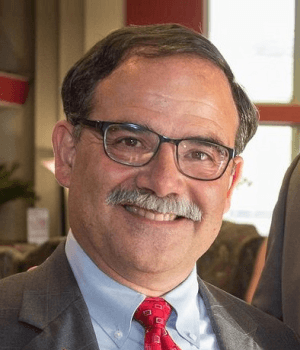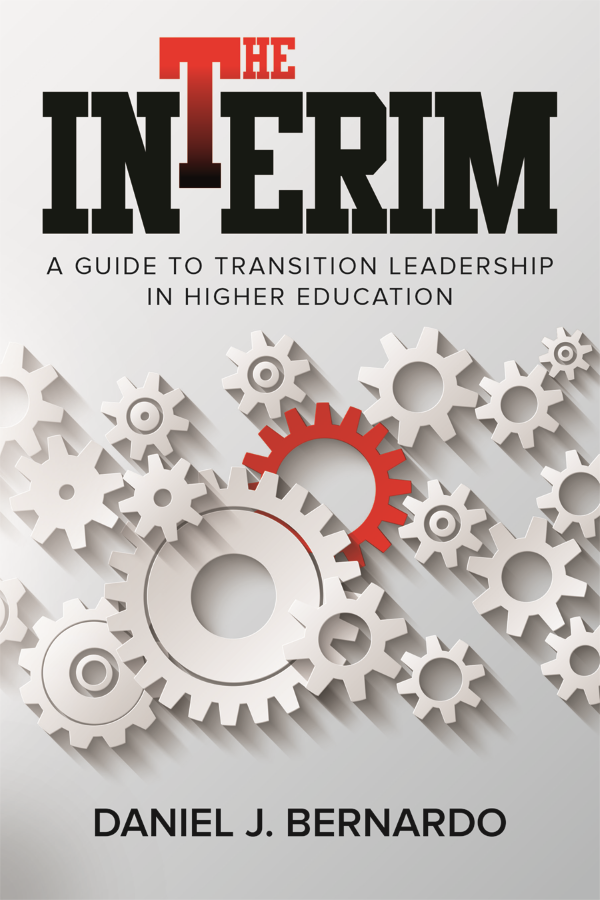November 1, 2022
Daniel J. Bernardo: Interim leaders aren’t just placeholders

Too often, interim leaders are expected to tread water while an institution searches for a replacement. That’s an important opportunity lost, both for the person and for the organization, says the author of a book on interim leadership in higher education.
When Daniel J. Bernardo took over as interim president of Washington State University in 2015, he had to handle multiple crises — fast.
He and the university community were already grieving the death of their beloved president. FBI agents showed up in his office to tell him that the campus computer network had been infiltrated. A forest fire shut down the airport and threatened to delay the start of the semester. And a Fox News segment about online syllabi prompted a deluge of complaints.
“It’s amazing, as you probably know, what a firestorm that type of coverage can cause,” he said. “So we just had a whole convergence of things going on in that first month, and it was a trial by fire for sure.”

After surviving that initial trial, Bernardo went on to serve the university for the next year, until Kirk Schulz assumed the permanent role in 2016. Bernardo’s experience — and other interim roles he’s filled — inspired him to write a handbook for others stepping into such a position.
The book, “The Interim: A Guide to Transition Leadership in Higher Education,” offers a five-stage plan, structured chronologically from positioning yourself for success to the handoff. Drawn from his own experience and research as well as more than 30 interviews with other interim leaders, it also includes specific advice about things from budget management to time management to developing a 30-day plan.
Bernardo, who now serves as a senior adviser to his successor, spoke with Faith & Leadership’s Sally Hicks about his experience as an interim leader and why he thinks that job can make a difference in the life of an institution. The following is an edited transcript.
Faith & Leadership: Explain a little bit about how you became interim president of WSU.
Daniel J. Bernardo: I had been in a couple of interim roles prior to that, but the interim presidency was truly unique. It was an interesting time, a difficult time. We’d had a really charismatic leader — a native of North Carolina.
Elson S. Floyd was president of the University of Missouri System prior to us. [Before that], he was president of Western Michigan. He was a Tar Heel — went up the ranks [at UNC] and also got all his degrees there. Anyway, he was a dynamic guy. Really, really fun to work for. He really elevated us in terms of reputation.
Unfortunately, he contracted colon cancer while he was in office and died rather suddenly. The kind of leader he was, he didn’t really take time away from his position to treat his illness. There was only a two-week period between when he stepped down temporarily and when he passed, so there was little preparation. It caught a lot of people by surprise. So it was a very, very fast transition.
F&L: I know you had a rough start. In the end, what did you enjoy about serving in the role of interim president?
DJB: This is my alma mater, so to be interim president of a place that’s really special to me, that’s truly what I enjoyed most. And I particularly enjoyed the external relations role. And being an alumnus was a huge advantage.
I did ask that question of most people I interviewed for the book. Their answers weren’t about things like, “Oh, we restructured this” or, “We introduced this new program.” It was really about service to the organization and advancing the culture and moving the organization forward. I think that the challenge of interim positions is fun.
It’s exciting. It’s exciting and gratifying, because you can really get a lot done.
I look back on each of those organizations that I led in an interim way and I think we set the table nicely. And that’s a really important thing — the interim has to set the table for the next person. Even to the extent of, what kind of written documents do you want to hand over?
I feel like I handed over an organization that was much better organized, at least, than the one I inherited. Even though I revered Dr. Floyd, one thing he wasn’t particularly good at was annual reviews. He was a relationship guy, right?
Dr. Floyd had 35 direct reports, which he could manage, but no mere mortal could do that. So we got it down to 17, and we did some restructuring in that way.
I think it’s gratifying to hand it over to somebody. And in every case, they really appreciated what had been done.

F&L: The central message of your book is that one should not view an interim leadership position as being a caretaker. Talk a little bit about leading with a “bias toward action.”
DJB: What I’ve noticed over the years is that you’re asked either officially or informally to be a placeholder. If you adopt that philosophy, it’s going to be a significant time of treading water and missed opportunity for an institution. It’s not uncommon for institutions to have as much as a quarter of their leadership team led by interims.
And if you just carry that out and think about it just mathematically, if you will, that’s a lot of administrative years of opportunity risks, if it’s just the status quo.
It really does require that the person appointing the interim make it clear that that person has authority to move forward. That will be challenged by faculty, because they’re indoctrinated to the role of the status quo interim. You can quickly render that person ineffective by not being supportive.
Another thing about these interim roles that I found interesting was we think of them as six months to a year. But they can sometimes be indefinite. A good half of the people I interviewed had no time frame provided to them for their appointment. Even those that had a year time frame identified, for the majority of them, their appointments lasted longer than a year.
F&L: You also talk about how it’s a unique opportunity and that interim leaders can do things that are needed because they’re time-limited. What can an interim do that a permanent replacement couldn’t do as easily or as effectively?
DJB: An interim that is not pursuing the job permanently certainly has the ability to make some changes that perhaps somebody coming into the role might be averse to.
Unfortunately, more and more circumstances prevail where interims are in the role of what I call the clean-up-the-mess interim. Those are scenarios in which there are very large problems to address within the college or the vice presidential unit.
And in those circumstances, the interim has the advantage of being able to address those issues aggressively, where a new person might be reluctant to do that. The interim typically comes from that same institution, so they tend to have a much better perspective on the institutional norms.
F&L: What are some examples?
DJB: The most common from the people I talked to and that I’ve encountered were personnel or culture issues. So certainly, those personnel issues and changing the culture of an organization are areas that an interim can plug into and make some significant progress.
It can be organizational. Some of the people that I talked with were involved in reshaping organizational structure. Interims are often used in establishing new organizations. For example, in a new college or new vice presidential area, there might be an interim there to try to set this organization up.
That can be a really productive use of an interim, because some of those things require people with the institutional knowledge, and also making some tough decisions that allow them to hand off the organization to a more permanent person.
F&L: You lay out five stages of an interim leadership position. There are two things that run through all of them. One is relationships, and the other is communication. Why are those two things important in particular for an interim?
DJB: Those are probably the two critical elements of any leadership position. I think, first of all, with respect to communications, one of the real challenges with an interim position is the time frame and the fact that everything is compressed.
I suggest creating a 30-day plan instead of what’s typically thought of as a 100-day plan. So everything is compressed, and that makes it even more important that you invest in relationships and that you invest in communication.
It’s very important to prioritize, and it’s very important to stop and build relationships along the way, and invest in those relationships on the front end. It’s important so that you have your team with you along the way. Some of the challenges an interim has are because of the impermanence with that team.
It’s important to be strategic with your communication — not only what you say but what you don’t say, because everything you do will be interpreted. In most of these interim situations, there is an information void inherent in the situation. And if people don’t know what’s going on or don’t have the necessary information, they’ll make it up, as you know, right?
F&L: One of the things you talk about is diversity, equity and inclusion as being a vital part of an interim leader’s work. And you point out that even if there is a DEI plan, it might not really make a difference in the culture. How do you figure that out?
DJB: Again, it’s communicating that that’s important and talking to people about it, people who might have a perspective on that. The only way to do that is to talk to people who may be affected by that culture.
When I first became a dean, I inherited a place that had real culture problems, especially around women in the workplace. And once I opened that up as an issue and began to talk to people about it, I was pleasantly surprised how many people, once they figured out that we were going to take it seriously, came quickly forward to help identify the issue and help develop some real action steps.
We identified three tenured faculty in the college. We developed a case against each of them where either they were going to resign or we were going to be in court with them, and they opted out. But yeah, it probably will involve some tough personnel actions, because these things don’t happen by themselves.
F&L: Another step you advise is making a learning plan. Why?
DJB: This [role] is not only something that’s good for the organization; it needs to be good for you, right? So you need to be very conscious upfront about, “What is it that I want to learn from this experience, and how am I going to go about doing that?”
Sometimes you think you don’t have time to learn, but if you want to maximize the benefits to yourself in terms of professional development, you need to invest in yourself through this process as well.
For example, one thing that I wish I had done was to keep a daily journal. First of all, to make this book a lot easier! But also, it would remind you of all of those learning opportunities that you went through along the way.
For example, the budget can be a challenge for some interim leaders. Well, this is a chance to learn, “How do I go about taking a budget and implementing it and holding people to that budget?” Those are great skills that a lot of deans and vice presidents have to develop on the fly.
F&L: You have really detailed suggestions, templates for all kinds of actions. And when I read it, I thought, “My gosh, for a person who probably is already overwhelmed by the job, that seems like a lot.” But you have also a specific strategy for freeing up time. What do you recommend?
DJB: Time management is one of the real keys to being a successful interim, and I make some very specific suggestions. The first one is don’t accept the predecessor’s schedule as your own. You have different priorities, and there’s a tendency for some interims to go in and keep all the same meetings and try to run the same schedule.
Spend some time analyzing, where does your time go? One of the key suggestions is don’t try to have 100% of your 8-to-5 time committed to doing meetings and donor visits and all of the specific activities of the job, and not budget out time for things like email, phone conversations, etc.
That is a ticket to burnout. Many of the people I interviewed suffered that way. They just tried to outwork the job. We all do that.
It’s my bias, but I use my administrative staff quite differently than many of my peers. I require a really outstanding administrative assistant — or what I would call chief of staff — and a really outstanding CFO.
And I’d always find it interesting that when people would come to interview, they would talk about the faculty and everybody else but they wouldn’t talk about the most important person to me. And that is my chief of staff, my go-to person. You can delegate a lot to that person. And I just think that delegation is absolutely the requirement.
But that burnout is significant. There were four or five people I interviewed that had significant adverse health reactions to their interim positions. They weren’t ready for the time demands that they imposed on themselves or the stress of that job. Fortunately, they were able to get out of it in time and get back to some normalcy.
F&L: And when you say use administrative staff differently, you mean invest them with real responsibilities so that your workload is reduced?
DJB: Part of that is that the CFO, for example, and that executive assistant are in every leadership meeting you’ve got, because they have to know what you’re trying to accomplish so that you can trust them to make decisions based upon your goals.
Not everybody treats their CFO that way. They just go in and talk to him or her as needed. I think that an HR person’s the same way. A real time sink for administrators is personnel, as you mentioned. And if you have an HR person who is in sync with you, he or she can buy you a lot of time.
F&L: Is there anything I didn’t ask you that you would want to add to our conversation?
DJB: A key recommendation that many people should adhere to is do not keep your previous job. Do not try to do two jobs, because you will do two jobs poorly.
I regularly saw that as a significant issue. Either the interim stayed in the former role or they mentally couldn’t disconnect from the former role. So you’ve got to have confidence in the [replacement] and let them do their thing.
And that goes back to the theme that these people have to be empowered. If they’re all doing nothing proactive, that’s a pretty significant tread-water time for the university.


Share